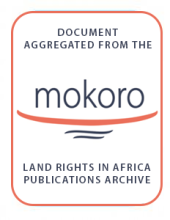Land Library
Welcome to the Land Portal Library. Explore our vast collection of open-access resources (over 74,000) including reports, journal articles, research papers, peer-reviewed publications, legal documents, videos and much more.
/ library resources
Showing items 1 through 9 of 52.Includes overview;the problem: Development Finance Institutions (DFIs) finance a destructive model;current situation: DFIs write off loans;impacted communities face repression;human rights abuses;the role of European DFIs;recommendations.
This study explores how local communities reflect on institutional frameworks and protected area governance in two national parks (NPs) with similar nature values in Estonia and Russia, and aims to understand the role of value systems in these interactions.
Combining socio-cultural valuations of ecosystem services with ecological and monetary assessments is critical to informing decision making with an integrative and multi-pronged approach.
A worldwide introduction of renewable energy has been required to reduce greenhouse gas emissions. Concomitantly, this has caused conflict between renewable energy development and local communities over landscape changes.
The accelerated development of new urban areas has an impact on changes in the spatial use and complexity of ecosystems.
Following the massive expansion of rubber plantations in China, considerable research has been conducted on the impact of these landscape changes. The general consensus is that there have been negative impacts on the environment and positive impacts on local economies.
Liberia has long maintained a dual land tenure system over statutory and customary lands characterized by unclear terms of ownership. Most rural Liberians depend on common resources for their survival. These are largely communally owned;used and managed.
The value of Traditional Ecological Knowledge (TEK) for informing resource management has long been recognized; however, its incorporation into ecosystem services (ES) assessments remains uncommon.
Understanding how individuals, communities, and populations vary in their vulnerability requires defining and identifying vulnerability with respect to a condition, and then developing robust methods to reliably measure vulnerability.






